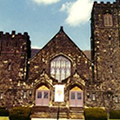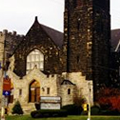 In 1836 Robert Curling established the Fort Pitt Sunday School in his glass factory at Franklin and Washington Streets in the Lower Hill to provide his workers and others a rudiment of secular education that they might study the Bible. On August 22, 1850, sixteen charter members received authorization as the Sixth Presbyterian Church of Pittsburgh, so named because it was the sixth of its denomination formed in Pittsburgh. Its church was built at the corner of Franklin and Townsend Streets. As an “Old School” Church, it was theologically and socially conservative. That changed with the Civil War. The congregation thrived in its location until the last decades of the 19th century. As the area’s demographics changed, there were fewer Presbyterians in the area. In April 1901, the church was sold to Beth Jacob congregation. The site disappeared under the Civic Arena, which has itself now disappeared.
In 1836 Robert Curling established the Fort Pitt Sunday School in his glass factory at Franklin and Washington Streets in the Lower Hill to provide his workers and others a rudiment of secular education that they might study the Bible. On August 22, 1850, sixteen charter members received authorization as the Sixth Presbyterian Church of Pittsburgh, so named because it was the sixth of its denomination formed in Pittsburgh. Its church was built at the corner of Franklin and Townsend Streets. As an “Old School” Church, it was theologically and socially conservative. That changed with the Civil War. The congregation thrived in its location until the last decades of the 19th century. As the area’s demographics changed, there were fewer Presbyterians in the area. In April 1901, the church was sold to Beth Jacob congregation. The site disappeared under the Civic Arena, which has itself now disappeared.
 In the early 20th century, Squirrel Hill was remote, but it was at the end of a new streetcar line. Property was bought from Thomas Wightman at the corner of Forbes and Murray Avenues. Ground was broken in 1902. The neighborhood grew and so did the church.
In the early 20th century, Squirrel Hill was remote, but it was at the end of a new streetcar line. Property was bought from Thomas Wightman at the corner of Forbes and Murray Avenues. Ground was broken in 1902. The neighborhood grew and so did the church.
 By 1912, Sixth was debt free and well attended. Sixth sent 75 fathers and sons to the First World War. The congregation was active in the community and firmly in favor of prohibition. A manse was built next to the church, and in 1924 a Sunday School building was erected behind it.
By 1912, Sixth was debt free and well attended. Sixth sent 75 fathers and sons to the First World War. The congregation was active in the community and firmly in favor of prohibition. A manse was built next to the church, and in 1924 a Sunday School building was erected behind it.
Despite relatively difficult periods during the Depression, Sixth had 1,128 members when it celebrated its 100th anniversary in 1950. There were multiple services, prayer meetings, fellowship societies, children and youth groups, and six mission oriented or Bible study groups. The church supported missionaries abroad and at home Nonetheless the 100th Anniversary Book closed with words of a changing neighborhood and suburban flight.
By 1969, only a dedicated core remained. The church, in an aging building and severely reduced in numbers, carried on with social programs, including a Korean Fellowship and a coffee house for youth, and purchased an adjacent home for a youth program. John McCall became Sixth Church’s pastor in 1970 and remained for thirty years, despite the extreme leanness of the early ones during which the Korean Fellowship became strong enough to seek its own home, the adjacent house burned down, and the building became older and older. Various fixes were explored. In 1981, an architectural survey provided a plan and numbers that told what was necessary. A congregational vote was taken, and the decision made to remain as a church at Forbes and Murray.
With hard work by members, careful stewardship of resources, great generosity of members past and present, and a multi-year option on the church’s adjacent property, the situation improved. Flowers were planted; building repair was undertaken; young support staff was hired; programs were developed; and new, vigorous members arrived.
By the time John McCall retired in 2003, Sixth had increased its membership and become a More Light church.
While strong physically and spiritually on the inside, the church by the 1990s was grimy on the outside. A cleaning was undertaken, with remarkable success.
The new look more accurately reflects what’s going on inside the building, but both inside and out, physically and spiritually, there is always much more to be done.





